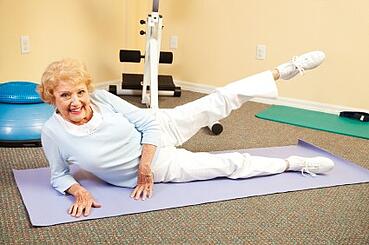You've probably heard by now that physical inactivity  is associated with an increase in risk for a wide range of illnesses, including heart disease, diabetes, and certain cancers among others. Unfortunately, the rates of inactivity go up the older you get. According to survey data from the Centers for Disease Control and Prevention, in 2008 32.7%--almost a third--of adults 65 and over reported NO leisure-time physical activity within the prior month.
is associated with an increase in risk for a wide range of illnesses, including heart disease, diabetes, and certain cancers among others. Unfortunately, the rates of inactivity go up the older you get. According to survey data from the Centers for Disease Control and Prevention, in 2008 32.7%--almost a third--of adults 65 and over reported NO leisure-time physical activity within the prior month.
Recently-updated exercise guidelines from the American College of Sports Medicine call for adults, seniors included, to get at least 150 minutes of moderate intensity exercise each week. For seniors looking to start a workout routine, you should consider these eight factors when you make your plan.
1. Safety first. Medications, vision and hearing problems, illness and inexperience can all affect a senior's ability to exercise safely. You should always get a physician's clearance before beginning a new workout routine, and especially if you're a man over age 45 or a woman over age 55. Certain conditions, like osteoporosis, arthritis, heart disease or diabetes require special care to design a workout routine that is safe and effective. And learning the proper form and exercise technique is essential for a safe workout routine.
2. Start slowly and build up gradually. Listen to your body to find the right level. You should be challenged, but not exhausted or in pain. If you give your body time, it will adapt and get stronger, but if you push too hard at the start, you're likely to get injured or discourage.
3. Include strength building. As you age, you begin to lose muscle mass as well as bone mass, and resistance training helps both problems. Workout routines for seniors should always include some form of resistance training. That could mean a weight lifting program, a workout with elastic bands, or a workout that uses body weight as the resistance. Include strength training 2 or 3 times per week, but leave 48-72 hours for recovery between sessions.
4. Include endurance training. Endurance applies to both muscle endurance and cardiovascular endurance, and it describes your ability to sustain an activity level over time. Using a scale of 0-10 to describe your perceived level of exertion, you should begin a new exercise program in a light to moderate zone of 3-5. As you get more fit, you can gradually increase your exertion level to 6 or 7. Strive to build up to 30-60 minutes of moderate exertion at least five days per week.
5. Include balance elements. As we age, our risk of losing our balance and falling increases. Vision or inner ear problems can affect your balance as can medications you may be taking. Much of our age-related balance trouble, though, is caused by muscle weakness. A lack of core strength and lower body strength can lead to instability and falls. Building that muscle stability along with practicing shifting the center of gravity over a changing base of support can increase balance in seniors.
6. Include flexibility training. Gentle stretching and range of motion exercises can help seniors maintain the flexibility they need to move freely and without pain. Muscles, ligaments and tendons all tend to tighten with age, but regular use can help keep them pliable and loose. It's a good idea to end your workout with a few gentle stretches while the muscles are still warm.
7. Keep it social. For many seniors, the best part about a workout routine is the chance to interact and socialize with others. A group fitness class, or even working out with a trainer can bring an element of socialization that's often missing for seniors.
8. Keep it functional. For seniors, the goal of a workout is less about vanity and more about feeling good and managing the tasks of daily life. A good workout routine for seniors includes exercises that emphasize all five movement patterns that are essential to daily living, including bend and reach, single leg, rotational, pushing and pulling movements.
It's never too late to begin a workout routine, and seniors can experience tremendous gains in strength, endurance, balance and flexibility. Workout routines can be easily adapted for seniors at any level of experience and fitness, and the benefits of regular activity last a lifetime.
(photo credit: Lisa F. Young)


